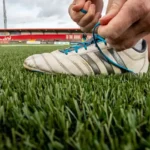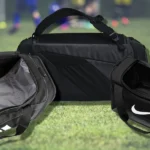Tackling isn’t just about going in hard; it’s about timing, control, and smart positioning. Whether you’re a fullback or a central defender, winning tackles can change the momentum of any match. Good defending frustrates opponents, protects your goal, and keeps your team in control. In this article, we’ll cover six practical and proven soccer defending tips to help you win more tackles, stay out of trouble, and become the kind of defender every coach counts on.
From body shape and footwork to reading the play, these tips will sharpen your game and make sure you stand out on the pitch. Let’s get right into it.
1. Stay on Your Feet
One of the biggest mistakes defenders make is going to ground too early. While slide tackles can look impressive, they should be a last resort.
Why It Works
Staying on your feet gives you the flexibility to change direction quickly and recover if you’re beaten. When you’re upright, you can jockey the attacker, pressure them into a poor decision, or block passing lanes. The best defenders don’t dive in — they delay, contain, and strike at the right moment.
Expert Insight
Premier League defender Virgil van Dijk is known for rarely going to ground. He focuses on positioning and timing instead of diving in. According to Opta stats, Van Dijk averages fewer than 0.5 fouls per game — proof that discipline and standing tall pay off.
Key Point: Keep a low center of gravity, bend your knees, and shuffle instead of lunging. You’ll win more tackles simply by not taking yourself out of the play.
2. Improve Your Body Positioning
Body positioning is everything when defending one-on-one. A slight adjustment can force the attacker away from goal or toward their weaker foot.
How to Use It
Angle your body to show the attacker away from the danger zone — usually toward the sideline. Keep your hips open and stay side-on, never square. This makes it easier to mirror their movements and step in with a tackle when they expose the ball.
Supporting Data
A UEFA study on youth development found that defenders who maintain side-on body positioning win 20–30% more tackles than those who defend flat-footed. That’s a massive advantage at any level.
Quick Tip: Watch the attacker’s hips, not their feet. The hips don’t lie and will show you where they’re really going.
3. Time Your Tackles
It’s not just about aggression — it’s about precision. A well-timed tackle is clean, effective, and stops an attack dead in its tracks.
What to Watch For
Look for moments when the attacker pushes the ball too far ahead or shifts weight onto one foot. That’s your cue to step in and take the ball. Don’t stab or poke; use the side of your foot for control. A mis-timed tackle doesn’t just give away a foul — it could lead to a goal or even a card.
Real-World Example
N’Golo Kanté, a defensive master, uses anticipation to perfection. He waits for the attacker to commit, then steps in smoothly. His timing helps him average over 2.5 successful tackles per match, with minimal fouls.
Remember: Be patient. Most successful tackles are won by waiting, not charging in.
4. Read the Game Like a Pro
Defending isn’t just physical — it’s deeply mental. The best defenders anticipate plays before they happen.
Build Your Awareness
Constantly scan the field. Look at where attackers are moving, where passes might go, and how your teammates are positioned. This allows you to intercept or press at the right time instead of reacting late.
What the Stats Say
According to InStat, defenders who check their surroundings every 2-3 seconds are 42% more likely to intercept passes. Positioning is easier when you’re already tuned into the flow of play.
Helpful Practice: Watch professional matches and pause before a tackle or interception. Ask yourself: “What would I do here?” It builds your pattern recognition and tactical IQ.
Internal Link:
5. Communicate With Your Teammates
Tackling isn’t a solo job — it’s part of a team effort. Communication ensures everyone knows their role and limits confusion.
Why It Matters
Talk to your teammates: shout instructions, call out danger, and let them know when you’re stepping in. This coordination avoids defensive gaps and helps trap attackers. The most organized defenses are also the hardest to break down.
What to Say
Use short, loud phrases: “Left shoulder!” “No turn!” “Man on!” These trigger instant reactions and tighten team shape.
Quick Tip: Stay vocal — even when the ball’s far away. Early communication prevents last-minute scrambles.
6. Master the Art of Jockeying
Before any tackle, you need to slow the attacker down. That’s where jockeying comes in.
What Is Jockeying?
It means delaying the attacker by shadowing them, keeping space, and forcing them into a mistake. Your goal is to guide them away from goal or into a dead-end, then pounce.
When to Jockey
Use it when you’re 1v1 and the attacker is facing you. Don’t rush. Keep a strong stance, maintain distance, and wait for them to misstep.
Coach’s Insight
Defensive coaches at top academies stress jockeying as the “foundation of control.” A well-jockeyed attacker loses rhythm and is easier to tackle or double-team.
Reminder: Patience wins. Most attackers want you to commit. Jockeying forces them to think twice.
Pros & Cons of Aggressive Defending
Pros:
- Breaks opponent momentum early
- Builds confidence and assertiveness
- Can inspire teammates and crowd energy
Cons:
- Higher risk of fouls or cards
- Easier to be beaten if mistimed
- Requires excellent positioning and awareness
Frequently Asked Questions (FAQs)
Who should use these soccer defending tips?
Anyone from youth players to pros can benefit. These principles apply across all levels and positions.
What’s the most important skill in tackling?
Timing. If you time your tackle right, everything else falls into place.
Where should you tackle — high or low on the ball?
Aim low and solidly around the middle of the ball to avoid fouling and maximize control.
Why do defenders get booked so often?
Mistimed tackles, poor positioning, or panic. These tips help prevent all three.
How can I get better at reading the game?
Watch matches, ask questions during training, and stay vocal on the pitch.
Will these tips work in small-sided games too?
Yes. In fact, close-quarters defending in 5-a-side or futsal can sharpen your skills even faster.
Conclusion: Step Up and Own the Defensive Game
Winning tackles takes more than grit — it takes brain, balance, and boldness. With these soccer defending tips, you’ll become smarter, sharper, and more reliable at the back. Stay on your feet, time your tackles, read the game, and communicate like a leader. Whether you’re eyeing a starting spot or just want to tighten up your game, these steps will set you apart.
Now it’s your turn: Which tip will you apply first? Drop a comment below, share this article with your team, and bookmark it for your next match. Tackling is an art — and now, you’re ready to master it.










